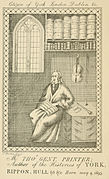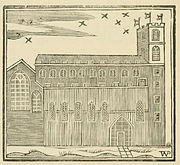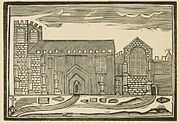Thomas Gent
Thomas Gent | |
|---|---|
 Thomas Gent, in later life, mezzotint based on an oil painting by Nathan Drake | |
| Born | 4 May 1693 Ireland |
| Died | 19 May 1778 York |
Thomas Gent (1693, Ireland – 1778, York) was a printer and writer, born in Ireland, who spent most of his working life in York. He authored several works, mostly histories, but was financially unsuccessful.
His poetry and the woodcut illustrations in his publications are considered to be of a low standard, but his historical accounts, as well as details in his own autobiography are considered to be valuable historical resources.
Biography[]
Thomas Gent was born to parents of ordinary background. His father was an Englishman, and he was baptised a Presbyterian. His parents ensured he educated himself during his childhold, and in 1707 he began an apprenticeship with Stephen Powell, a printer of Dublin.[1]
Gent's apprenticeship was an unhappy one, and in 1710 he absconded, and stowed way on a ship, arriving in Wirral, England, then travelled to London where he took up apprenticeship under Edward Midwinter.[1] After completing his apprenticeship in 1713, he worked briefly for a Mrs. Bradford, and then for a printer named Mears, who involved him in a humiliating initiation rite, discharging him soon after, following which he subsisted by labouring. After several months he obtained a post with John White, King's printer for York, at a rate of £18 a year, plus board and lodging, arriving in April 1714. There he met Alice Guy, whom he would later marry, who became the object of his affections.[2]
At the end of a year with White, Gent would not renew his contract until he had returned to Ireland and visited his parents, but was compelled to leave on account of his former apprentice-master attempting to have him seized for absconding. After a period in York he returned to London, and again entered the employment of Midwinter; in 1717 he was admitted to the Company of Stationers, and became a freeman of London the same year.[3]
He briefly returned to Ireland again, visiting his parents, and returned to London, taking up employment under a Roman Catholic named Clifton, meeting Atterbury, Bishop of Rochester, for whom he printed a defence of an imprisoned Clergyman.[4][5] Gent was sought by Midwinter on a number of occasions to return to work with him, eventually leaving the troublesome Clifton.[6] Gent was briefly arrested, on suspicion of printing treasonable works, and placed in prison for five days, but was acquitted without charge.[7][8]
Gent was seeking to establish himself as a printer in his own right, so that he had the means to marry Alice Guy. However she married Charles Bourne, grandson of John White and inheritor of his printshop, in 1721. Alice was widowed in 1724, and Gent travelled to York, marrying her in York Minster in December 1724, and by marriage, obtained a print business in York. Gent became publisher of Yorkshire's only newspaper, the Original York Courant, or Weekly Journal, previously the York Mercury.[9][1]
John White Jnr, printer of Newcastle, son of John White, who had hoped but failed to obtain the York Press for himself set up a rival business in York; the competition prompted Gent to begin to author his own works, and he published a history of York in 1730, followed by one of Ripon in 1733, and of Hull in 1735.[10][1] Gent's paper ceased publication in 1728, and White's The York Courant became the predominant local paper.[11] Also in 1735 he began publication of a journal Miscellanea Curiosa, concerned with mathematical and other problems – the publication was not a success.[12]
In 1741 Gent published a history of England, with it a history of Rome in the second volume.[12] From the 1740s Gent's business went into decline, due to competition from John White Jnr., and other printers who had set up in York; he lost the lease on his house and print premises in Stonegate in 1742, and moved to a house in Petergate, where he continued to publish but with reduced output. He publisher several works covering religious topics, in poem form, the first being The Holy Life and Death of St. Winefred.[1]
On 1 April 1761 his wife, Alice died. His circumstances were much reduced in the last decades of his life, struggling with illness, and poverty, relying on the charity of friends. He died on 19 May 1778, and was buried at St. Michael-le-Belfry in York.[1][13]
Legacy[]
Thomas and Alice Gent's only child Charles died in early childhood in 1726.[1]
Thomas Federer characterised Gent as the pre-eminent producer of chapbooks in Yorkshire during his career.[14] Gent's poetry was of an uninspired quality, Tedder describes it as "beneath criticism", Gent's own woodcuts were also primitive.[15][16]
He is best known for his local histories of Hull and York and Ripon, which contain information not noted elsewhere, and are the earliest discrete histories of those towns; Gent's works are considered to be based on genuine research, observation or recording, and not based on a regurgitation of other accounts, and contain descriptions of objects not extant at the time of writing of later histories.[17][1][18]
Works[]
Gent is known to have published more than sixty works,[19][20] his authored works include:
- God's judgments shewn unto mankind. Being a true and sorrowful relation of the sufferings of the city of Marseilles in France, 1720[21]
- The forsaken lover's letter to his former sweetheart, 1722[21]
- Divine entertainments: or, penitential desires, sighs, and groans of the wounded soul, 1724[21]
- Gent, Thomas (1730), The Antient and Modern History of the famous City of YORK ..
- Gent, Thomas (1733), The History of the Loyal Town of Rippon
- Miscellanae curiosae: or entertainments for the ingenious of both sexes, 1733[21]
- The pattern of piety: or, tryals of patience, 1734[21]
- The pattern of piety: or, Tryals of Patience. Being The Most Faithful Spiritual Songs of the Life and Death of the once Afflicted Job, 1734
- Annales Regioduni Hullini : Or, The History of the Royal and Beautiful Town of Kingston-upon-Hull.., 1869 [1735], reprinted. (with additional large illustrations by John Haynes.[22])
- Pater patriae: being, an elegiac pastoral dialogue, 1738[21]
- Historia Compendiosa Anglicana: Or, A Compendious and Delightful History of England ... A succinct History of ROME, from its Foundation by Romulus 'till the Fall of K. Tarquin.. An Appendix, relating to York .. A further Historical Account of Pontefract, 1741
- British piety display'd in the glorious life, suffering, and death of the blessed St. Winefred, 1742[21]
- The Holy Life and Death of St. Winefred and other Religious Persons in Five Parts, 1742
- The History of the Life and Miracles of our Blessed Saviour Jesus Christ from His Birth to His Cruxifixion. As also the lives, sufferings and death of the Evangelists and Apostles
- Piety Display'd in the Holy Life and Death of the Antient and Celebrated St. Robert, Hermit, at Knaresborough.. (2 ed.)
- Gent, Thomas (1762), The most delectable, scriptural, and pious history of the famous great easter window ... in St. Peter's Cathedral, York
- The pious and poetical works. 11 parts, 1734–72[21]
- Gent, Thomas (1761), The Contingencies, Vicissitdues or Changes of this transitory Life..., transcript with notes of a performed prologue
- Poetical pieces by Thomas Gent, 1772[21]
- Set forth the unhappy Birth, wicked Life, and miserable End of that deceitful Apostle, Judas Iscariot.., 1772
Autobiography[]
- Gent, Thomas (1832) [1746], Life of Mr. Thomas Gent, Printer of York; written by himself

Thomas Gent

St. Mary Lowgate, Hull

St. Mary's Whitby

Hull from the Humber
See also[]
References[]
- ^ Jump up to: a b c d e f g h Tedder & Barr 2004.
- ^ Dobson 1907.
- ^ Ohlson 1869, pp. 13–14.
- ^ Gent 1832, pp. 85–90.
- ^ Ohlson 1869, pp. 14–15.
- ^ Gent 1832, pp. 95, 110–113.
- ^ Gent 1832, pp. 120–126.
- ^ Ohlson 1869, pp. 15–17.
- ^ Ohlson 1869, pp. 15, 17–18.
- ^ Ohlson 1869, pp. 19–22.
- ^ Federer 1889, pp. 18–19.
- ^ Jump up to: a b Ohlson 1869, p. 24.
- ^ Ohlson 1869, pp. 26–7.
- ^ Federer 1889, p. 9.
- ^ Dictionary of National Biography, Vol. 21 (1890)
- ^ Federer 1889, p. 21, quote: Of Gent's literary activity it is difficult to speak without admiration : true, some [..] affect to sneer at Gent's attainments, and have nothing but contempt for the rude woodcuts and vile typography of his later productions.
- ^ Davies 1868, p. 144.
- ^ Federer 1889, pp. 21–22, quote: Mr. Hunter, whose authority as an historian and antiquary is unquestioned, and who is no mere amateur critic, declares that "Gent's performances were not, like too many modern books of topography, mere bundles of pillage from the works of ingenious and painstaking authors, but contained matter honestly collected, and not, before his time, made public by the press." The extent of his miscellaneous and general information, the result of an indefatigable course of reading and research, was enormous ; and his data are correct to an astonishing degree. The editor of the present volume has verified some hundreds of Gent's references to works of the most varied description, and found every one of them strictly accurate.
- ^ Federer 1889, p. 22.
- ^ Davies 1868, pp. 162–227.
- ^ Jump up to: a b c d e f g h i Radcliffe, David (ed.), "Thomas Gent (1693–1778) : Publications", Spencer and the Tradition: English Poetry 1579–1830 (spenserians.cath.vt.edu)
- ^ Peltz, Lucy. "Haynes, John". Oxford Dictionary of National Biography (online ed.). Oxford University Press. doi:10.1093/ref:odnb/12780. (Subscription or UK public library membership required.)
Sources[]
| Wikisource has original text related to this article: |
- Chalmers, Alexander (1812), "Thomas Gent", General Biographical Dictionary, 15:402
- Davies, Robert (1868), A Memoir of the York Press: with notices of authors, printers, and stationers, in the sixteenth, seventeenth, and eighteenth centuries, Nichols and Sons
- Dobson, Austin (1907), "Thomas Gent, Printer", Eighteenth-Century Vignettes. Third Series, pp. 105–33
- Federer, Charles A., ed. (1889), Yorkshire Chap-Books, 1. Comprising Gent's tracts on Legendary Subjects; with a memoir of the Author, and a select number of facsimile reproductions of the original woodcuts
- Knight, Charles (1865), "IV. Thomas Gent, Printer, of York", Shadows of the old booksellers, Bell and Daldy, OL 7156410M
- Ohlson, G (1869), Notices of the Life and Works of Thomas Gent, Printer of York, pp. 11–27, prefaced in an 1869 reprint of the 1735, Gent's History of Hull, "Annales Regioduni Hullini"
- Tedder, H. R.; Barr, C. B. L. (2004). "Thomas Gent". Oxford Dictionary of National Biography (online ed.). Oxford University Press. doi:10.1093/ref:odnb/10519. (Subscription or UK public library membership required.)
- Timperley, C. H. (1842), "Thomas Gent", Encyclopaedia of Literary and Typographical Anecdote, 2:742–43
External links[]
| Wikimedia Commons has media related to Thomas Gent (1693-1778). |
- British printers
- People from York
- British historians
- History of York
- 1693 births
- 1778 deaths
- Members of Parliament for Maldon



